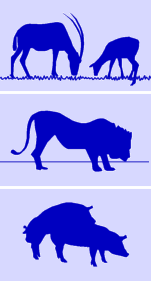|
|

|
|
Basic “drives” in animals
Are animals basically inert and must be “driven” to feed, drink, and copulate? Or are they simply alive and therefore sometimes hungry, thirsty, and ready to mate?
|
|
|
In contemporary scientific discussions, the word "drive" is no longer used as often as before. Many scientists have, in fact, rejected the concept altogether. They do not see any real advantage in describing hunger as a hunger drive, and instead of talking about animals “satisfying their thirst drive”, they prefer to say simply that animals drink because they are thirsty. Furthermore, the idea that animals are basically inert and have to be "driven" into activity is increasingly being questioned. Nevertheless, the concept of "drive" has retained some appeal for psychologists who want to describe motivations that have some physiological basis. Thus, in textbooks of psychology, the term "drive" may be defined as an "aroused condition in which an organism's behavior is directed toward avoiding discomfort or a state of physiological imbalance". Drives in this sense are, for example, hunger, thirst, the need for sleep, and the need for moderate temperatures. A lack of food, liquid, and sleep, or a temperature that is either too hot or too cold activates the drive. The greater the imbalance, the stronger the drive. By the same token, when sufficient food, liquid, and sleep, and a moderate temperature have been obtained, the drive is satisfied until a new imbalance activates it again. Finally, it is clear that these drives perform a vital function for the organism. Without food, liquid, or sleep, and in boiling or freezing temperatures, the organism would eventually die.
|